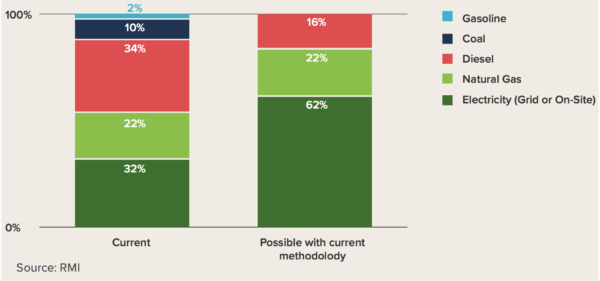Like it or not, mining, in general, will remain part of the global economy for decades to come. As the insight brief outlines, there is great untapped potential to achieve gigaton-scale carbon reductions in the mining industry. Mining represents between 1 to 11 percent of world energy consumption, depending on the source. In terms of generation and capacity, that represents 56 GW of capacity and 434 TWh of generation. Given renewables lower capacity factors, powering the mining industry would require 180 GW. With only 1 GW worth of renewables constructed and another 1 GW in the pipeline, there is much to be done.
Achieving full decarbonization of the mining industry will require electrifying many processes that run on diesel. Currently, 32 percent of the mining industry runs on electricity, though outside of trucking, every other mining function can be electrified, from digging to moving raw minerals. And even trucking is not impossible to electrify.
Moving materials account for 40 percent of mining’s total energy consumption. Mines rely on diesel trucks to move these materials, though most of this movement occurs along fixed routes where the trucks can be replaced with electrified conveyor belts. The RMI estimates the average mine in the US can convert an additional 30 percent of its existing energy load.
The image below shows the RMI’s estimates for shift energy sources.

Drivers of Adoption
Deployment of renewables is being driven by economics. Lazard’s recent Levelized Cost of Electricity study finds that solar is definitively cheaper than diesel generators throughout the globe and is cheaper than most gas peaker plants. A Navigant study finds that wind and solar dominate renewable construction in the mining industry with wind deployments being slightly greater than solar.
The mining industry’s adoption of renewables fits into a large trend of increasing renewable capacities on and off the grid. A McKinsey study of Africa’s power potential finds that economic forces will increase renewables to 26 percent of total capacity by 2040.
Popular content
In addition to economic forces, governments in mining-heavy nations will be decarbonization their electricity system and mining industry in accordance with their commitments to the Sustainable Development Goals and the Paris Agreement.
Chile has 20 percent renewable target by 2025 under the Paris Agreement. Since 38 percent of all Chile’s electricity goes to the mining industry, achieving the renewable target will involve significant deployments of renewables in the mining industry.
Renewables also present an opportunity for mining companies to improve their social license to operate by offering local jobs in construction and operation as well as providing additional revenue and electricity.
Once a mine has been shut down, reclamation remains an economic challenge for mining companies. A grid-connected renewable source can provide revenue to pay for the reclamation. While off-grid mines do not offer the same revenue potential as on-grid mines, the off-grid mines can serve as an anchor tenant for minigrids supplying power to local communities.
Sunshine for Mines Initiative
The Sunshine for Mines initiative that produced the insight brief seeks to facilitate the acceleration of renewable adoption to reach 8 GW of capacity across the mining sector by 2025. This acceleration is achieved through consulting with existing mines through the feasibility and procurement stages of renewable adoption and by exploring innovative conceptions on how electrification and load flexibility can be practiced on mining sites. The initiative is also pushing the idea of repurposing closed mining sites into renewable facilities to maximize the useful life of the land. As the insight brief states, “the race is long but, on a plat lifetime basis, the economics speak loud and clear in favor of renewable energy”.
Article written by Dustin Zubke, off-grid correspondent for pv magazine
This content is protected by copyright and may not be reused. If you want to cooperate with us and would like to reuse some of our content, please contact: editors@pv-magazine.com.


By submitting this form you agree to pv magazine using your data for the purposes of publishing your comment.
Your personal data will only be disclosed or otherwise transmitted to third parties for the purposes of spam filtering or if this is necessary for technical maintenance of the website. Any other transfer to third parties will not take place unless this is justified on the basis of applicable data protection regulations or if pv magazine is legally obliged to do so.
You may revoke this consent at any time with effect for the future, in which case your personal data will be deleted immediately. Otherwise, your data will be deleted if pv magazine has processed your request or the purpose of data storage is fulfilled.
Further information on data privacy can be found in our Data Protection Policy.